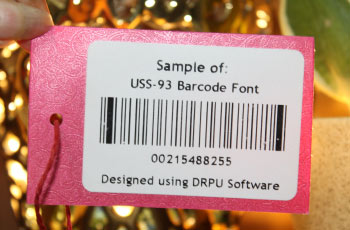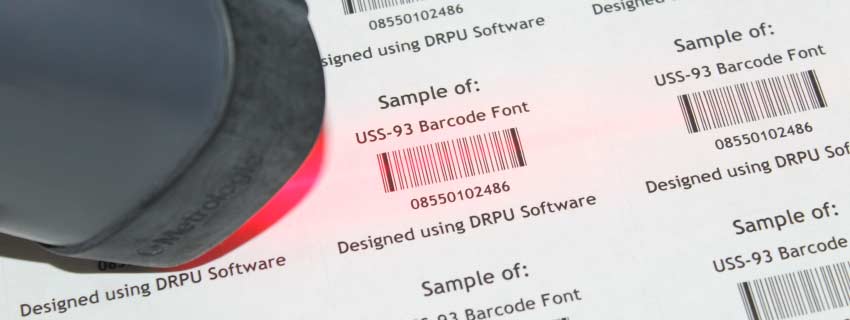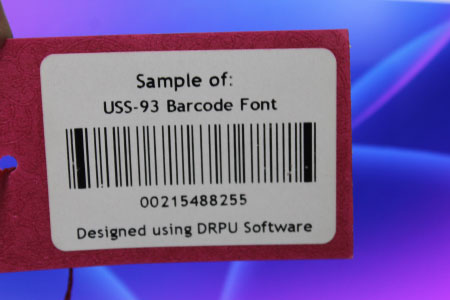Advantages of Using USS-93 Barcode
The advantages of using USS-93 barcode include:
-
Cost-Effective:
USS-93 barcode is a cost-effective option for small to medium-sized businesses that require barcode labeling. The equipment and software required to generate and print USS-93 barcodes are relatively affordable, making it a popular choice for small business owners.
-
Error Correction:
USS-93 barcode uses two check digits to ensure accurate data transmission and reduce the risk of errors in scanning and decoding. This feature is particularly useful in industries that require high levels of accuracy and reliability, such as healthcare and pharmaceuticals.
-
Wide Scan Angle:
USS-93 barcode can be read at a wide angle, up to 45 degrees, making it easy for barcode scanners to read the code from different angles and positions. This feature reduces the need for precise positioning of the barcode and speeds up the scanning process.
-
Versatile Applications:
USS-93 barcode can be used in various applications, such as inventory management, asset tracking, and point-of-sale systems. Its flexibility makes it suitable for use in a wide range of industries, including retail, manufacturing, and logistics.
-
High Data Density:
USS-93 barcode can encode up to 47 alphanumeric characters, including uppercase letters, numbers, and a few special characters, within a small barcode. This makes it ideal for labeling small products and items with limited space.
-
High Security:
USS-93 barcode has a high level of security, as it requires a checksum digit and two start/stop characters to encode the data. This makes it difficult for unauthorized users to alter or modify the barcode, ensuring the integrity of the data encoded in the code.
-
International Standard:
USS-93 barcode is recognized as an international standard by the International Organization for Standardization (ISO), which ensures that the barcode can be read and decoded by different barcode scanners worldwide. This feature is particularly useful for companies that operate in multiple countries and need to comply with different barcode standards.
📝 Overall, USS-93 barcode offers many advantages over other barcode types, making it a popular choice for businesses that require accurate and reliable data encoding and decoding.
Limitations of Using USS-93 Barcode
There are a few limitations of using USS-93 barcode that should be considered:
-
Limited Character Set:
USS-93 barcode can only encode a limited set of characters including numbers, uppercase letters, and some special characters. This means that it may not be suitable for applications that require encoding a large amount of data or non-standard characters.
-
Low Data Density:
USS-93 barcode has a lower data density compared to other barcode types such as Code 128 or QR codes. This means that it may not be suitable for applications where a high amount of data needs to be encoded in a small space.
-
Limited Error Correction:
USS-93 barcode has limited error correction capabilities, which means that if any part of the barcode is damaged, the entire barcode may be unreadable. This can result in errors during scanning and may require manual data entry to correct.
-
Susceptibility to Damage:
USS-93 barcode can be easily damaged by scratches, dirt, or other types of physical damage. This can cause the barcode to become unreadable and result in errors during scanning.
-
Limited Application:
USS-93 barcode is not widely used in all industries, and it may not be compatible with all barcode readers or scanners. This means that it may not be suitable for certain applications or industries.
-
Not Ideal for Small Items:
USS-93 barcode requires a certain amount of space to be printed and scanned fastly and accurately. This means that it may not be suitable for very small items where space is limited.
Overall, while USS-93 barcode has its advantages, it also has several limitations that should be considered when choosing a barcode type for a particular application.
Generate a USS-93 Barcode

Generating a USS-93 barcode can be done in several ways, including using barcode generation software or online barcode generators. Here are some steps to generate a USS-93 barcode:
🟆 Choose a Barcode Generation Software or Online Barcode Generator: There are several software programs and online barcode generators available that can generate a USS-93 barcode. Some popular options include Barcode Generator, TEC-IT Barcode Studio, and BarcodesInc.
🟆 Input Data: Once you have selected a barcode generation software or online generator, you will need to input the data you want to encode in the barcode. This can be done by typing the data into the software or uploading a file containing the data.
🟆 Select Barcode Type: Select USS-93 as the barcode type you want to generate.
🟆 Choose Settings: Depending on the software or online generator you are using, you may be able to customize settings such as barcode width, height, and orientation.
🟆 Generate Barcode: Click the button to generate the USS-93 barcode. The barcode will appear on the screen and can be saved as an image file or printed.
It is important to ensure that the data being encoded is correct and that the barcode is generated accurately. It is recommended to test the barcode before using it in production to ensure that it can be read and decoded correctly.
Print a USS-93 Barcode
To print a USS-93 barcode, you need to have a printer that supports barcode printing and software that can create and print the barcode image.
Here are the steps to print a USS-93 barcode:
- ➦ Choose a USS-93 Barcode Generator Software: There are various barcode generator software available in the market. Some popular ones include Barcode Studio, TEC-IT Barcode Studio, CodeSoft, Bartender, and Labeljoy. Choose one that meets your needs and budget.
- ➦ Install the Software: After downloading the software, install it on your computer.
- ➦ Select the USS-93 Barcode Type: Open the software and select the USS-93 barcode type from the list of supported barcode types.
- ➦ Enter the Data: Enter the data that you want to encode in the barcode. USS-93 can encode numeric data only.
- ➦ Customize the Barcode: You can customize the barcode by adjusting its size, color, font, and other parameters.
- ➦ Preview and Test the Barcode: Preview the barcode and test it by scanning it with a barcode scanner.
- ➦ Save the Barcode: Save the barcode in a format that your printer can support. Commonly used formats include BMP, JPEG, and PNG.
- ➦ Print the Barcode: Open the saved barcode image and print it using a printer that supports barcode printing. Make sure that the printer is set to the correct size and resolution.
- ➦ Verify the Printed Barcode: After printing, verify the barcode by scanning it with a barcode scanner to ensure that it is scannable and contains the correct data.
Summary: To print a USS-93 barcode, you need to use barcode generator software to create the barcode image, save it in a compatible format, and then print it using a printer that supports barcode printing.
Download and Install Barcode Software
Scan a USS-93 Barcode
USS-93 barcodes can be scanned using a variety of barcode scanners, which use different methods to read and interpret the barcode data. The most common types of barcode scanners are handheld scanners, fixed-mount scanners, and mobile devices with built-in scanners.

❖ Handheld barcode scanners are the most commonly used type of scanner, and they typically use a laser or imaging technology to read the barcode. When a handheld scanner is used to read a USS-93 barcode, the scanner emits a laser beam or captures an image of the barcode, which is then decoded into the underlying data. The decoded data is then transmitted to a computer or other device for further processing.
❖ Fixed-mount scanners are used in applications where the barcode needs to be read automatically, without the need for manual scanning. These scanners are typically installed in conveyor systems, sorting machines, or other types of automated equipment. Fixed-mount scanners use a variety of technologies to read the barcode, including laser, imaging, or camera-based systems. The barcode is read as it passes through the scanner, and the data is then transmitted to a computer or other device for further processing.
❖ Mobile devices with built-in scanners are becoming increasingly popular, as they provide a convenient and portable way to scan barcodes. These devices typically use imaging technology to capture an image of the barcode, which is then decoded into the underlying data. The decoded data is then transmitted to a computer or other device for further processing.
❖ To scan a USS-93 barcode, the barcode must be positioned correctly within the scanner's field of view. The scanner should be held steady and level with the barcode, and the barcode should be well lit and free from any obstructions or damage. The scanner should also be configured to read USS-93 barcodes, and any necessary drivers or software should be installed and configured on the scanning device.
❖ Once the barcode is scanned, the decoded data can be used for a variety of purposes, such as inventory management, product tracking, or point-of-sale transactions. The accuracy and reliability of the scanned data will depend on the quality of the barcode and the scanning equipment, as well as the conditions in which the scanning takes place.
USS-93 barcodes can be read using a variety of devices including handheld barcode scanners, fixed mount scanners, and mobile devices such as smartphones and tablets. The type of device that is required will depend on the specific application and environment in which the barcode is being used.
Handheld barcode scanners are commonly used in retail and industrial environments to quickly and easily scan barcodes. These scanners typically use a laser or LED to read the barcode and can be connected to a computer or mobile device via a cable or wireless connection. Some models may also include features such as Bluetooth connectivity, batch scanning, and ruggedized designs for use in harsh environments.
Fixed mount scanners are used in automated systems such as conveyor belts and production lines to scan barcodes as items move through the system. These scanners can be configured to read barcodes at high speeds and can be integrated into larger systems such as warehouse management and inventory control systems.
Mobile devices such as smartphones and tablets can also be used to read USS-93 barcodes using the built-in camera and barcode scanning software. This makes it easy for businesses and consumers to quickly scan and access information about products and services. Many mobile apps also support additional features such as barcode scanning from images and generating barcodes for products and promotions.
📝 Overall, the flexibility of USS-93 barcode technology allows it to be read using a wide variety of devices, making it a popular choice for many different applications.
Cost of Implementing USS-93 Barcode
The cost of implementing USS-93 barcode can vary depending on several factors such as the number of barcodes required, the type of printing technology used, and the software required to generate and manage the barcodes. Here are some of the factors that can impact the cost of implementing USS-93 barcode:
- 01 Barcode Software
To generate and manage USS-93 barcodes, you will need software that can create the barcodes and print them onto labels. The cost of barcode software can range from free to several thousand dollars, depending on the features and functionality you need.
- 02 Barcode Printer
You will need a printer capable of printing USS-93 barcodes. The cost of a barcode printer can vary depending on the features, print resolution, and speed. A basic barcode printer can cost a few hundred dollars, while a high-end industrial printer can cost several thousand dollars.
- 03 Labels
You will need to purchase labels that are compatible with your barcode printer. The cost of labels can vary depending on the size, material, and quantity you need.
- 04 Maintenance
Barcode printers require regular maintenance and replacement of parts, such as printheads and rollers. The cost of maintenance and replacement parts can add up over time.
- 05 Training
Depending on the complexity of the software and hardware you are using, you may need to provide training to your employees to ensure they can use the equipment and software effectively. Training costs can vary depending on the type and duration of the training.
- 06 Integration
If you need to integrate the USS-93 barcodes into an existing system, you may need to hire a developer to help with the integration. The cost of integration can vary depending on the complexity of the system and the level of customization required.
📝 In summary, the cost of implementing USS-93 barcode can range from a few hundred dollars to several thousand dollars depending on the specific requirements of your organization. It is important to carefully evaluate your needs and budget before investing in barcode technology to ensure that you choose the right solution at the right price.
USS-93 Barcode Can be Used Internationally
USS-93 barcode, also known as Code 93, is primarily used in the United States, but it can also be used internationally. The barcode is recognized by the International Organization for Standardization (ISO) and is listed in the ISO/IEC 15420 standard, which specifies the barcode symbology.
